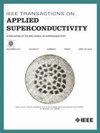The Torus Axial Flux Machine: Unlocking a Low-Loss Superconducting Armature?
IF 1.8
3区 物理与天体物理
Q3 ENGINEERING, ELECTRICAL & ELECTRONIC
引用次数: 0
Abstract
High-temperature superconductors (HTSs) could enable a new paradigm for lightweight and efficient electric machine designs. While superconducting rotors have been successfully implemented, the adoption of superconducting armatures has been hindered by high ac losses, leading to impractically high cryogenic cooling demands. This article introduces a slotted torus axial flux machine topology to address this challenge, leveraging toroidal windings to align HTS tapes with slot leakage flux, avoiding complex end windings while achieving ac losses at least an order of magnitude below HTS armatures with tooth-coil tape orientation. A 1-MW proof-of-concept aviation motor design demonstrates the feasibility of this approach, achieving an active torque density of 51.1 Nm/kg with HTS ac losses below 0.03% of the output power and total cryogenic losses slightly exceeding 0.1% when including the steel losses. The study highlights the importance of HTS tape orientation within the slot and using flux diverters for the end windings to minimize losses. Furthermore, it illustrates how an even higher cryogenic efficiency can be reached by lowering the electrical frequency. The promising results motivate further development and optimization of superconducting machines with this topology.环面轴向磁通机:解锁低损耗超导电枢?
高温超导体(HTSs)可以为轻量化和高效的电机设计提供新的范例。虽然超导转子已经成功实现,但超导电枢的采用一直受到高交流损耗的阻碍,导致不切实际的高低温冷却需求。本文介绍了一种开槽环面轴向磁通机拓扑结构来解决这一挑战,利用环面绕组将HTS带与槽漏磁对齐,避免了复杂的端绕组,同时使交流损耗至少比带齿圈的HTS电枢低一个数量级。一个1兆瓦的概念验证航空发动机设计证明了这种方法的可行性,实现了51.1 Nm/kg的主动扭矩密度,高温超导交流损耗低于输出功率的0.03%,当包括钢损耗时,总低温损耗略超过0.1%。该研究强调了高温超导胶带在槽内定向的重要性,并在末端绕组使用磁通分流器以尽量减少损耗。此外,它说明了如何通过降低电频率来达到更高的低温效率。这些有希望的结果激励了这种拓扑结构的超导机器的进一步发展和优化。
本文章由计算机程序翻译,如有差异,请以英文原文为准。
求助全文
约1分钟内获得全文
求助全文
来源期刊

IEEE Transactions on Applied Superconductivity
工程技术-工程:电子与电气
CiteScore
3.50
自引率
33.30%
发文量
650
审稿时长
2.3 months
期刊介绍:
IEEE Transactions on Applied Superconductivity (TAS) contains articles on the applications of superconductivity and other relevant technology. Electronic applications include analog and digital circuits employing thin films and active devices such as Josephson junctions. Large scale applications include magnets for power applications such as motors and generators, for magnetic resonance, for accelerators, and cable applications such as power transmission.
 求助内容:
求助内容: 应助结果提醒方式:
应助结果提醒方式:


